© 2023 Dr Margaret Sheppard
Hierarchy
This hierarchy changes over time and different writers provide different hierarchies. Lord Buddha ALWAYS heads the hierarchy and all other Deities are positioned well below him. His authority is secured through the delegation of warrants to the other supernatural beings including Deities in the Hierarchy. Images of Lord Buddha -
Lord Buddha
The Lord of the Deities: Sakkra
The Four Guardian Deities:
Vishnu - (Although Vishnu is originally a Hindu Deity, the Buddhists have adopted him as a Buddhist Deity often referring to him as Uppalavanna). He is the ruler of the West.
Saman - ruler of the Hill Country and the North
Kataragama (Hindu name is Skanda), - ruler of the South
Vibhishana or Natha - ruler of the East
The Twelve Deities:
According to Wirz (p. 136-
The first three in the list are the ones mainly attributed with spreading diseases, especially in the form of epidemics and plagues, among mankind in order to afflict and punish them for their transgressions. They are:
Devol -
Pattini -
Kataragama -
Natha -
Saman -
Bibisana (or Vibisana), -
Ganpathi -
Gini-
Vahala,
Dadimunda, also a yakku-
Mahavishnu, -
Isvara or Shiva
Beings Half way between Deities and Demons :
Devol, Suniyam(Hanamun), Dadimunda
Village Deities :
E.g. Madua Bandara, Laksmi
Human Beings
Animals
Rakse demons :
Naga powerful inhuman beings mostly living in water. They may like to gain merit undertaking good acts in order to be reborn higher in the Hierarchy. Some have Deity-
Yakku demons :
E.g. Mahasona, Riri-
Earth Spirits
Ghosts
Hungry ghosts -
Bahirawa -
Jungle Spirits
Asura -
Mara -



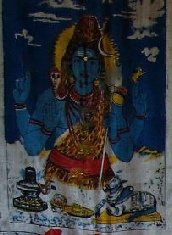

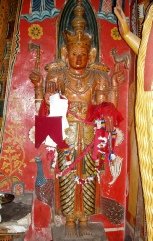

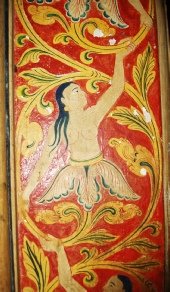








Perhaps the most dangerous of the Deities is Devol because it is he who is responsible for most of the more serious life threatening epidemics and venereal diseases. Pattini afflicts people with less serious epidemics such as small pox, scarlet fever or mumps. Kataragama is the cause of slighter illnesses such as fever, headaches, abscesses, and ulcers. Isvara can cause ailments of the limbs e.g. rheumatism, general aches and pains, and diseases of the skin.

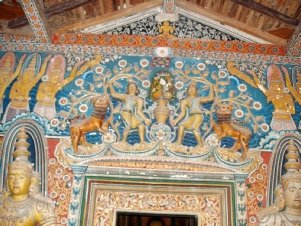



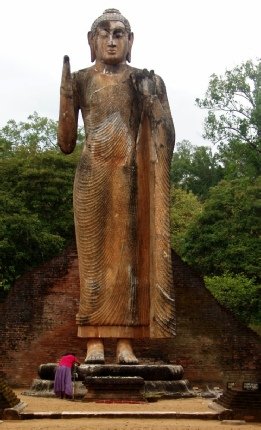
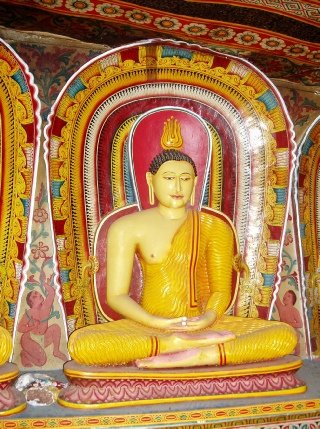
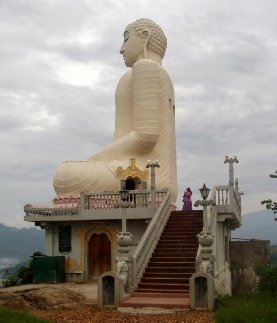

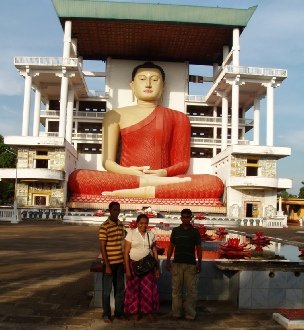


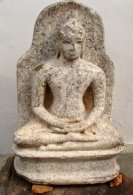

Gigantic statues of Lord Buddha overlooking the surrounding countryside. Typically these are illuminated at night, shining out over the surrounding countryside.



Buddha in cave temple
Temple panel painting
Lord Buddha with monks
Buduruwagala -



Temple paintings of Lord Buddha. On the left Buddha overcoming the demons, On the right preaching to monks . N.B the Deities in the background.
Deities behind Buddhist monks
Ancient sculpture
There is common agreement that there are Four Guardian Deities and some of these are included in the Twelve Deities. Those who have moved nearer to the state of Nirvana in which Lord Buddha is situated are less involved in human affairs than those who are not so close to achieving it. Natha who is believed to be the next Buddha after Gautama Buddha, is the least involved in human affairs as are other Deities also positioned closer to this state.
Usually only three Deities are believed to be the cause of troubles and illnesses. They are Devol-


This following list is only a simplified version and is in descending order. (Many of the Deities have been adopted from Hindu Deities but renamed in Sri Lanka):
Some perceive Buddhist practices under three broad headings. The first two categories are associated with lay Buddhist activities while the third, is associated with rituals adapted from folk religions. Deity and Demon rituals are a mixture of Buddhism and an earlier pre-